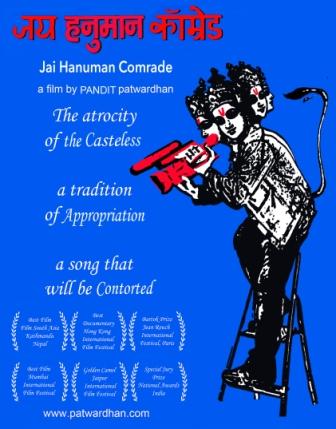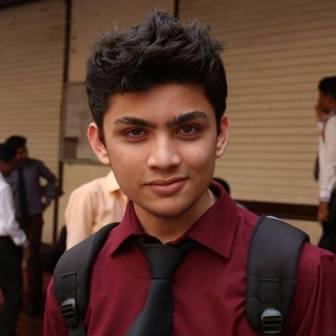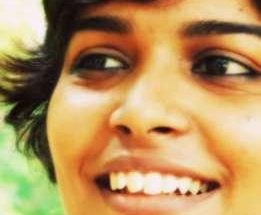Dhurwa R.
Anand Patwardhan’s Jai Bhim Comrade is one of the best examples of how brahminical powerplay makes a farce out of the most hard fought battles put up by Dalits, and does that rather patronizingly. Before I even watched the film, the title itself (and the media hype with one of its first screenings planned in Ramabai Nagar) had raised doubts in my mind. That perhaps it would be another attempt by a left Brahmin to rally Dalits towards the communists since Jai Bhim is a revolutionary assertion of Dalit identity and it almost always causes unease among non-Dalits, especially Brahmins/savarnas. Patwardhan has very cleverly used it as an attempt to deceive or mislead Dalits by adding the suffix – Comrade, a word used typically by the indian left lost in their imagined revolution. One can also see that this is perhaps the earlier seed for the strange mantra and highly misleading slogan of ‘Jai Bhim – Lal Salam’, fashionable among indian leftists of late.

Artwork by Pinak Banik
The racist generalisations of brahmin media/academia
This documentary may give one a feeling that events are unfolding themselves and that it is a telling commentary on the turn of the events (explained later in this article). However, there’s enough commentary and judgments by Patwardhan that appear in English along with the subtitles which makes it amply clear that this is a premeditated attempt at belittling Dalits and to create suspicion among them towards each other. For example, on the backdrop of a rally by Republican Party of India his judgement appears/reads on the screen as: “The co-option of Dalits into the project of Hindutva has yielded rich dividends nationally for the BJP but as yet in Maharashtra the legacy of Dr Ambedkar acts as a shield against bigotry”. So essentially Dalits, except for those belonging to Maharashtra are getting “hinduised” according to Patwardhan. This judgement comes from Patwardhan around the year 2010-11 when his film would most likely have been in the final editing/post-production phase (the film released towards the end of 2011). This, he is commenting around the time when a Dalit woman, Mayawati, the chief minister of the India’s most populous state, Uttar Pradesh, is completing her five year term with an unprecedented control over law and order of a state that was most infamous for terror and caste violence prior to her reign. So would ‘hinduised’ Dalits bring a Dalit woman to power with an overwhelming majority, who in her previous brief stints as a chief minister had named several Universities and districts after events/people related to Ambedkar and Buddhsim? She was also recognised by the international media around the time of her government as one of the most influential women of the world.
Also, around the same time she was cornered by all Brahmin/savarna forces for the construction of Dalit Prerana Sthal, a one of its kind, which only further tells the story of Dalit assertion and how the savarna hegemony deals with it. Even now, other Brahmins like Ajay Gudavarthy who talk about the ‘rightward shift’ in Dalit politics, hide behind Mayawati’s subsequent failure in capturing power by highlighting the number of elected representatives rather than actual percentage deficit of 2 percent votes which has been more or less the difference in alternating SP-BSP governments.
In fact, many Dalits in northern states have even adopted the surname Baudha/Baudh (something rarely seen elsewhere in the country) after their exit from Hinduism and conversion to Budhism, follwing the path shown by Babasaheb. Patwardhan takes no congnisance of all this. This deception of Patwardhan only qualifies to best fit in Ambedkar’s definition of the “rogue intellectual” when he says:
“It is true that intellect by itself is no virtue. It is only a means and the use of means depends upon the ends which an intellectual person pursues. An intellectual man can be a good man but he can easily be a rogue. Similarly an intellectual class may be a band of high-souled persons, ready to help, ready to emancipate erring humanity or it may easily be a gang of crooks or a body of advocates of a narrow clique from which it draws its support. You may think it a pity that the intellectual class in India is simply another name for the Brahmin caste.”
(SECTION XXI Annihilation of Caste. Vol-I, BAWS)
So with one stroke of his brahminical judgement, Patwardhan erases all struggles by Dalits and Saheb Kanshiram who built this organisation, Bahujan Samaj Party, and brought Dalit politics at the forefront of the national imagination and provided the necessary impetus for Dalit assertion after Babasaheb. He neither presents any data nor any facts and makes a sweeping racist generalisation of ‘Dalits getting hinduised’.
Meddling with martyrs
On the backdrop of the massacre of Dalits in the year 1997 in Ramabai Nagar, Mumbai, he builds his story on the death of martyr Shahir Vilas Ghogre who gave up his life expressing solidarity with those killed in police ordered killing of the Dalits. He shows Vilas Ghogre’s footage singings songs about poverty and class inequality in the capitalist society. In this manner, he situates him in the communist narrative. Vilas Ghogre, however, with his disillusionment and bitter experiences with the ‘left’ Brahmins deserted them and took part in Ambedkarite Jalsas, programmes organised by various republican factions for which he was ridiculed by these same comrades right until his death. Even in his death he asserted his Ambedkarite identity when he wrote “Long live Ambedkarite unity” on the wall of his small hut in a Mumbai suburb as he gave up his life. This stung the communist comrades and hence Patwardhan too, leading him on this mission to ‘purify’ him. And of course with this agenda he is not fully honest in his portrayal of Vilas Ghogre. He does not show a single song by Vilas Ghogre on Babasaheb and Dalits, except a couple of lines of the song Jaltoy Marathwada, though that too played in the background. In many interviews, he claims that he has recorded Vilas Ghogre’s songs since 1985, but despite that none of the songs by Vilas Ghogre that play in the background are about Babasaheb or Dalits.
By naming this film with the suffix ‘Comrade’ added to the revolutionary ‘Jai Bhim’, Patwardhan has tried to reappropriate Vilas Ghogre’s struggle despite the latter denouncing Brahmin Marxists. He talks to the supposed ‘comrade’ of Vilas Ghogre, Mr. Gurbir Singh and asks him about Vilas Ghogre’s Ambedkarite assertion and the blue band he had tied as he took his life. This ‘comrade’ stung by such an assertion wryly says that it was a ‘purple band and not a blue band’!
Pandit Patwardhan and his comrades
Patwardhan may appear quite a “revolutionary” to some Brahmins like S. Anand (another Brahmin who has attempted appropriation of Babasaheb’s Annihilation of Caste by roping in celebrity Arundhati Roy) who wrote in the Outlook appreciating Patwardhan for “exposing” these comrades mocking the colour of the band. However, Patwardhan’s own duplicity and hypocrisy is so apparent in the main poster of his documentary Jai Bhim Comrade. In fact, he is far ahead of the comrades like Gurbir Singh when he makes sure that Vilas Ghorgre is shown with a RED cloth tied around his waist.
This brahmin project has Patwardhan’s comrades like Anupama Rao referring to it as a “take on Dalit Marxism”. This despite the denouncement by Shahid Vilas Ghogre of the Brahmin Marxists. Patwardhan seems to be on an agenda to redeem some ground for his Brahmin comrades and has resorted to such cheap tactics. If it is being projected as an attempt of reconciliation between Marx and Ambedkar, then there can be nothing farther from the truth. It is indeed true that Babasaheb was influenced by Marx and that is why he brings out the comparison between the two greats in his Buddha or Karl Marx. He does agree with Marx that the purpose of philosophy is not limited to merely interpreting the world but to reconstruct the world. At the same time, he never agreed with any kind of dictatorship including the “dictatorship of the proletariat”. In his own analyses, there never was a unified proletariat in India either, given the “graded inequality” characterising the caste system in India. But this the disgruntled Brahmins have labeled as a kind of ‘divisive politics’ employed by Babasaheb.
Casteless brahmins vs. ‘other caste’ beings
Marxism in India has been manipulated by Brahmins to suit their careers and vested interests. Perhaps that’s why Babasaheb, though influenced by Marx, still said that he was “the confirmed enemy of the communists” for he could well understand and foresee where the Brahmin-led Marxism in India was headed. Babasheb was talking from his own experience with these Brahmin Marxists. The telling example that could be cited here is when he was defeated in the 1952 elections, the leading Brahmin Marxist, S.A. Dange, supporting Congress, exhorted people to “waste” their vote but not vote for Babasaheb.

Illustration by Nidhin Shobhana
In India, Brahmins have been the chief exploiters of the Dalit Bahujan lives through their hegemony and unlimited social capital. Brahmins are the oppressor class and the carriers and chief proponents of brahminism. The Brahmins who engage in some sort of “social activism” tend to consider themselves casteless, a privilege not available to others, especially Dalits. And, unsurprisingly, Patwardhan does the same here. This is also evident in his other documentary Ram Ke Naam (In the name of God). He does feel the need to ask the identity of the people belonging to non-Brahmin castes in Ram Ke Naam. The people whom he questions about their caste identity invariably turn out to be chamars (cobblers) who are Dalits and oppressed, the other person whom he questions on caste, is out to demolish the Babri Masjid, as a foot soldier turns out to be a Bania. But even in Ram Ke Naam he didn’t question the caste of any individual who would turn out to be a Brahmin.
Importantly, he didn’t bring into question the caste of RSS chief functionaries who masterminded the whole episode of Babri demolition who happened to be Brahmins and there isn’t a single judgement on brahminism in this case. Contrast this with how his judgements on Dalits appear all through Jai Bhim Comrade. He doesn’t ask any Brahmin his caste and thus protects his own Brahmin identity and becomes casteless. So, in Jai Bhim Comrade he asks caste identity from Mahars who converted to Buddhism in Mumbai; in villages he asks other sub-caste people, Mangs, their caste who faced a caste atrocity and also asks the caste of the perpetrator who is from OBC (Vanjara). He even asks the caste identity of a non-Maharashtrian (most likely from UP/Bihar) small time vendor who supports Dalits thronging Shivaji Park on the eve of Mahaparinirvan Diwas on December 6. But he never asks their caste identity from the elite residents of Shivaji Park out for a walk who are so paranoid of Dalits “creating litter” on those days. Now it is needless to guess for someone from Mumbai or Maharashtra that these residents are mostly Brahmins since Shivaji Park has been the den of Brahmins for ages and has earlier been the residence of Savarkar and even the present RSS chief Mohan Bhagwat (both brahmins) often gets down there. This would not be understood by the audience who aren’t from Mumbai or Maharashtra. This is the deception by Patwardhan. Is he not protecting his fellow caste Brahmins from any kind accusations in this manner? This is how Brahmins have been for ages, always manipulating.
Reinforcing the Dalit stereotype as a ‘helpless victim’
In one instance, there is a clear resemblance to Arundhati Roy’s utterances that stereotype Dalits, also analysed in this brilliant take down by Joby Matthew. Patwardhan asks a youth at a coffee shop at Shivaji Park about Dalits visiting Shivaji Park. This young fellow talks with disdain about reservations and employement benefits “cornered” by Dalits. He further talks about dirt spread by Dalits visiting Chaityabhoomi at Shivaji Park on December 6. To which Patwardhan throws at him the typical stereotype “but they clean your filth” much like Roy’s talk of “if these people weren’t there none of the CEOs can even clean his shit”. There’s not a single argument by Patwardhan about social justice, reservation and affirmative action or brahminism that he presented to this youth. And of course, Patwardhan doesn’t enquire about the caste identity of this youth for obvious reasons.
One could say that perhaps he didn’t argue because he wanted to “expose” people’s attitude towards Dalits. But then “but they clean your filth” isn’t an argument either, it is only a stereotype presented and reinforced about Dalits, further trying to show them at the mercy of the oppressor, as helpless victims. This is how Brahmin messiahs reinforce the stereotype and virtually smother the very people to death whom they claim to be “rescuing”. This is how these Brahmin messiahs have only worked towards furthering the status quo.
In another instance, Patwardhan tries to show an attempt by Shiv Sena to co-opt Dalits by their slogans like “Shiv Shakti plus Bhim Shakti equals to Desh Bhakti”, as if Dalits are not capable of asserting themselves. This (failed) attempt of so called ‘co-option’ of Dalits by Shiv Sena supremo Bal Thackeray also has a history behind it. In the early 1990s when the power of Dalit Panthers was on the wane Bal Thackeray opposed the publishing of Babasaheb’s “Riddles in Hinduism” by the government, citing hurt caused to Hindu feelings and threatened to take to streets. It was Dalits who single handedly tamed Thackeray despite Shiv Sena taking to the streets. There were never-before-seen protest marches by Dalits on the Riddles issue in Mumbai and all over Maharashtra. In fact, it is only Dalits who have a history of having taken on Shiv Sainiks on the streets of Mumbai and giving them a taste of their own medicine. Bal Thackeray was finally defeated due to this assertion of Dalits. Immediately after agreeing to the publishing of Riddles, in the next issue of his weekely “Marmik” he exhorted Dalits as “Chala wad sampla samwad sadhuya (so dispute is over, let’s have a dialogue now!)”. Ever since then Thackeray tried to woo Dalits and never messed with them on the field, on the ground, openly. But Patwardhan’s documentary could not show any such assertion of Dalits, no protest marches by Dalits nor any clippings of Dalits during the Namantar struggle/Riddles issue despite his own claim of being in this video-shooting business since 1970s. This is how despite their hard earned self respect he tries to belittle Dalits by showing them as a helpless and incapable lot and tries to show Dalit movement as a failure. Depicting victorious Dalits can jeopardise the careers of these rescuing messiahs.
Indian left: a brahmin enterprise
At one of the shows organised at the Dharamashala Film Festival, Patwardhan expressed surprise that this film (Jai Bhim Comrade) unlike other films of his didn’t get trapped in censor board. Now this “surprise” is no surprise to the author’s mind. One has to understand what Patwardhan has depicted in the movie and also the political establishment in the power at the time the film went for clearance to the board. This whole film shows helpless, pitiable Dalits and on the other side he shows growing caste violence and blames it on the “right wing” Hindutva. One has to understand that atrocities on Dalits may have increased with openly casteist outfits like Shivsena and BJP, but even before Shivsena was born there was a series of incidents like Gaganbawda in Maharashtra which triggered the way for the establishment of Dalit Panthers in 1972, Shivsena was then just a 6 year old outfit and limited to few wards in Mumbai suburbs. Even BJP (or the then Jan Sangha) hardly had any presence in Maharashtra back then.
It is essentially Patwardhan’s complicity in protecting/obfuscating what is inherently hegemonic in this country, i.e. brahminism, which divides this society, and that gets him accolades from the liberal left Brahmins for whom bracketing Dalits and other oppressed in class dialectics rather than caste dialectics helps to maintain the ideological apparatus intact, thus privileging the Brahmin class. This point has been thoroughly analysed in Gaurav Somwanshi’s essay titled Dalit: Identity or Commodity for Savarnas?
The whole exercise by Patwardhan is about that inquisitive, perverse Brahmin gaze directed at Dalit Bahujans. These careerists have “interest” in the lives of the oppressed for furthering their own brand value and protecting fellow Brahmins, othewrise what else is Patwardhan’s or for that matter any Brahmin comrade’s contribution for the cause of Dalits or oppressed? Starting from the “flamboyant” M N Roy and industrialist sponsored “labour leader” Dange to foreign educated “desi” comrades like Basu, this communist enterprise has been a brahmin enterprise. They realise that no amount of organizational buildup could match the innate strength of Dalit conviction in an egalitarian society advocated by Babasaheb and hence they are always on the lookout for foot soldiers from among the Dalits. They have many professional henchmen doing this job for them like Anand Patwardhan in every important sphere, be it media, judiciary, journalism or academics. But the likes of Patwardhans are yet to fully understand what Babasaheb means to Dalits who rules their conscience. Even if the likes of Patwardhans feel that they have succeeded in misleading Dalits, in Namdeo Dhasal’s words, with their sanatan daya, they better watch out and read history again, better listen to their erstwhile Brahmin comrades’ experience. They will learn that Babasaheb still lives on through the consciousness of Dalits and he will keep defeating any and all kind of brahminical attempts of appropriation including the disguised ones by these “liberal, progressive, secular” Brahmins.
~~~
Dhruwa R., is an entrepreneur based in Mumbai.










